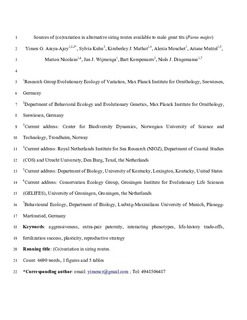| dc.contributor.author | Araya-Ajoy, Yimen | |
| dc.contributor.author | Kuhn, Sylvia | |
| dc.contributor.author | Mathot, Kimberley J | |
| dc.contributor.author | Mouchet, Alexia | |
| dc.contributor.author | Mutzel, Ariane | |
| dc.contributor.author | Nicolaus, Marion | |
| dc.contributor.author | Wijmenga, Jan J | |
| dc.contributor.author | Kempenaers, Bart | |
| dc.contributor.author | Dingemanse, Niels J. | |
| dc.date.accessioned | 2017-12-02T07:46:01Z | |
| dc.date.available | 2017-12-02T07:46:01Z | |
| dc.date.created | 2016-12-01T15:57:42Z | |
| dc.date.issued | 2016 | |
| dc.identifier.citation | Evolution. 2016, 70 (10), 2308-2321. | nb_NO |
| dc.identifier.issn | 0014-3820 | |
| dc.identifier.uri | http://hdl.handle.net/11250/2468813 | |
| dc.description.abstract | Males of socially monogamous species can increase their siring success via within-pair and extra-pair fertilizations. In this study, we focused on the different sources of (co)variation between these siring routes, and asked how each contributes to total siring success. We quantified the fertilization routes to siring success, as well as behaviors that have been hypothesized to affect siring success, over a five-year period for a wild population of great tits Parus major. We considered siring success and its fertilization routes as “interactive phenotypes” arising from phenotypic contributions of both members of the social pair. We show that siring success is strongly affected by the fecundity of the social (female) partner. We also demonstrate that a strong positive correlation between extra-pair fertilization success and paternity loss likely constrains the evolution of these two routes. Moreover, we show that more explorative and aggressive males had less extra-pair fertilizations, whereas more explorative females laid larger clutches. This study thus demonstrates that (co)variation in siring routes is caused by multiple factors not necessarily related to characteristics of males. We thereby highlight the importance of acknowledging the multilevel structure of male fertilization routes when studying the evolution of male mating strategies. | nb_NO |
| dc.language.iso | eng | nb_NO |
| dc.publisher | Wiley | nb_NO |
| dc.title | Sources of (co)variation in alternative siring routes available to male great tits (Parus major) | nb_NO |
| dc.type | Journal article | nb_NO |
| dc.type | Peer reviewed | nb_NO |
| dc.description.version | acceptedVersion | nb_NO |
| dc.source.pagenumber | 2308-2321 | nb_NO |
| dc.source.volume | 70 | nb_NO |
| dc.source.journal | Evolution | nb_NO |
| dc.source.issue | 10 | nb_NO |
| dc.identifier.doi | 10.1111/evo.13024 | |
| dc.identifier.cristin | 1407283 | |
| dc.relation.project | Norges forskningsråd: 223257 | nb_NO |
| dc.description.localcode | This is the peer reviewed version of the following article: [Sources of (co)variation in alternative siring routes available to male great tits (Parus major)], which has been published in final form at [http://onlinelibrary.wiley.com/doi/10.1111/evo.13024/abstract]. This article may be used for non-commercial purposes in accordance with Wiley Terms and Conditions for Self-Archiving. | nb_NO |
| cristin.unitcode | 194,66,10,0 | |
| cristin.unitname | Institutt for biologi | |
| cristin.ispublished | true | |
| cristin.fulltext | postprint | |
| cristin.qualitycode | 2 | |
